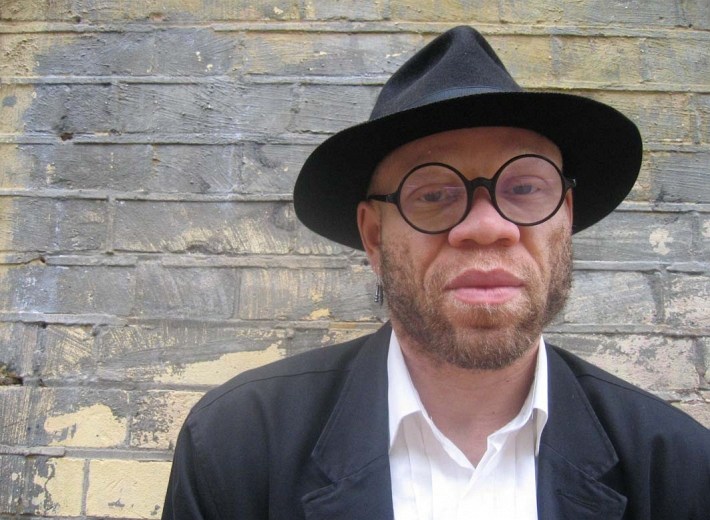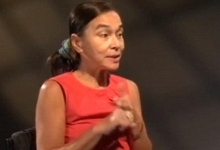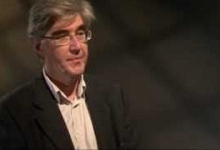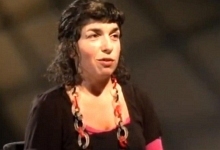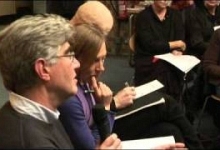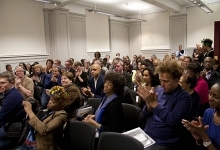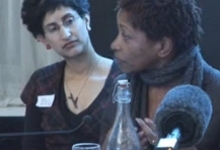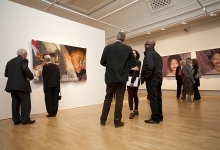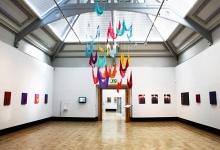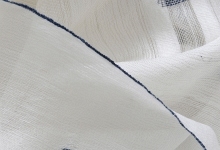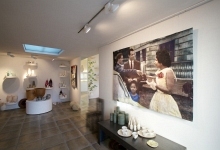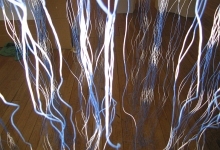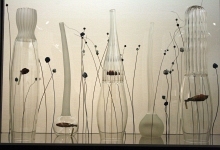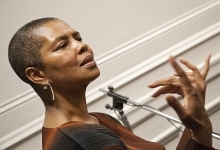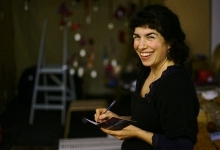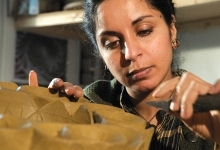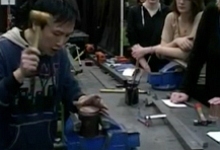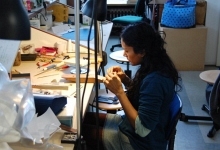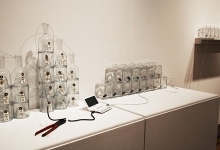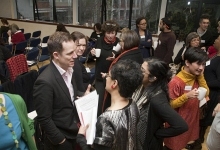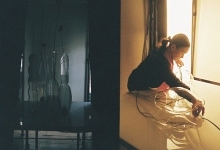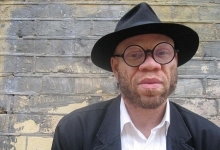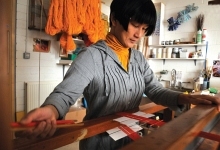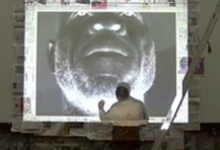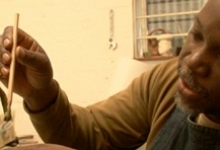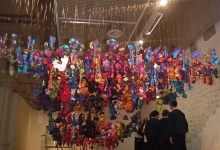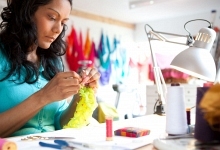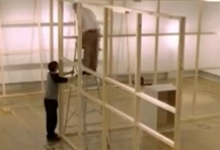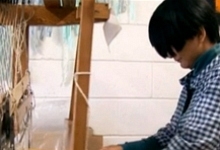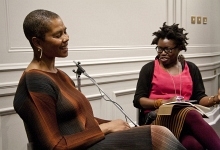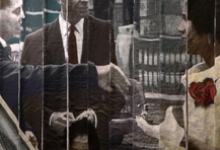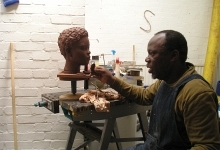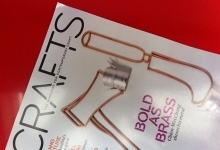We commissioned 18 essays to support the programme by Alison Britton, Julia Carver, Kathy Fawcett, Deirdre Figueiredo, Raimi Gbadamosi, Bonnie Greer, Caroline Griffin, Yvonne Hardman, Sophie Heath, Jessica Hemmings, Ellie Herring, Janis Jefferies, Teleri Lloyd-Jones, Frances Loeffler, Frances Lord, Alnoor Mitha and Simon Olding
Most of these were for the catalogues which can be found on the exhibitions and artists pages
Three were published on our original website by Raimi Gbadamosi, Deirdre Figueiredo and Caroline Griffin - read them below
Raimi Gbadamosi, artist curator and writer
ADAM: it’s not? / what is it, a pastie or something, like strippers have?
EVELYN: no, / it’s plaster . . . it was added by a committee who had complaints from local townspeople. / uh-huh. / they made a petition and got that put on, thereby removing its subjectivity as art
ADAM: really./ i didn’t know that . . . when did they do this?
EVELYN: seven or eight years ago now, i think, before I got here, see / anyway, they objected to his ‘thing’ the shape of it, said it was too life-like. (beat) it’s supposed to be ‘god’ you know . . . and that’s what pisses them off. ¹
Labute, Neil. The Shape of Things. Faber and Faber, London 2000. p. 9.
The perhaps over-used biblical definition of faith: ‘Now faith is the substance of things hoped for, the evidence of things not seen’², is appropriate when dealing with the conceptual basis of The Shape of Things. The very idea that things have shapes relies on an understanding that the ‘thing’ is identifiable and the ‘shape’ is recognisable amidst all the other shapes and things. The plurality of ‘things’ makes it difficult to isolate the shape, as the shape is not one thing any longer, it is a range of shapes, of various things competing for dominance amidst multitudinous permutations.
‘How are things?’ The colloquialism says more in three words than all the formal possibilities of ‘How are you?’ The specific nature of the second question makes the practised easy answering within polite society. Nobody truly wants to know how the other person is, particularly if they are unfamiliar. Even among friends, anything more than an automatic ‘Fine, thank you’ raises an eyebrow or two. One could go on to explain all that is wrong with the world, but the obligation of initial niceties remains in place. ‘How are things?’ however does not insist on the specifics of a given self. The questioner asks how ‘everything is, difficult to sum up within the casual relationship that bore it. ‘Things are good’ or ‘Things are fine’ may be given in response, but there is no expectation that any conclusive knowledge of ‘things’ is likely, compared to the personalised ‘you’.
The, social and political structure of British artistic society is the backdrop to understanding the shape things are presently in. Moving from the abstract to the concrete, the continuing exclusion of non-European British artists from the machinery of the mainstream, looms large. Artworks are supposed to speak for itself, a fine thesis, but this is impossible where the work is gagged and bound through lack of exposure. This is much more than placing objects in a gallery, it is the discourse that allows for an object to become art (in the first place) before appearing before an expectant public. It is realising the need to have practitioners and their work in gallery spaces alongside their peers as the only way to see how things truly are, for everyone. We cannot return to the tired arguments of quality, it is trite to even argue that the works in the various exhibitions are good, they may be, the works may even be awful by some estimates. The argument that looms is whether every British maker, regardless of origin, (class is a red herring here), has a fair chance within the subjective selection system, of some success, brilliance or mediocrity aside. It is the possibility to take part that means anyone can contribute to the whole.
The Shape of Things as a concept does not give much away. It does not tell us much of itself or what it is dealing with. It links itself to ‘thingness’ and notions of objectivity, and this is its paradoxical strength. Rather than attempt a definition of what this shape is supposed to be: the cultural landscape of Britain, artists express their understanding of a ‘hostile’ world through objects. It is tempting to clarify the project’s realty as an attempt to make ‘invisible’ makers visible (a la Ralph Ellison), but this will falter. Talks, exhibitions, and publications; curators, mentors, and champions; all the things that make artistic existence unique (and therefore visible) strategically given to ‘British’ artists somehow separate from their peers, the other ‘British’ artists. The Shape of Things therefore carries an awkward burden, through attempting to address ‘cultural’ bias through ‘cultural’ bias. Put this way, ‘everything’ is not fine (answering how things are), but this does not mean they will not get better. And highlighting the shape of things, through mirroring, may be the way to awaken an audience that chooses not to see them. On another note, perhaps it is time for the return of the ‘Ghetto Blaster’, with Fight the Power in full effect, reminding all who have ears that sometimes it takes ‘Any Means Necessary’, sometimes.
As a serendipitous aside, Neil LeBute’s play, The Shape of Things, is a good complement to looking at the represented series of nationwide exhibitions and events. Evelyn Ann Thompson (life, favour, son of twins) meets Adam Somerson (man, earth, son of the weather) and a pygmalic relationship ensues, except that Adam is alive and falls in love with his re-maker (who does not disclose her intention to eventually exhibit him and their liasions). Evelyn receives reward in making and exhibiting Adam, arguing that she improved his life by encouraging the changes he underwent when he complains. Who truly benefits in these exchanges, and does the expected beneficiary stand bereft at their ‘greatest’ moment: the point of exposure? Is one always doomed to question the intentions of any apparently ‘altruistic’ improvement programme, especially when a system turns inwards, scrutinising itself?
The artists in The Shape of Things are not passive, they play their part too. Herein lies the conundrum.
ADAM: well lucky me, i got to be part of your installation ‘thingie’.
EVELYN: you are my installation thingie . . . (beat) look if you hadn’t been here tonight, hadn’t heard all this stuff . . . wouldn’t you still be happy? Waiting at home for me, hoping this went well, wanting to make love . . .
ADAM: that’s not the point . . .
EVELYN: yes it is, it’s the total point, all that stuff we did was real for you, therefore it was real, it wasn’t for me, therefore it wasn’t. its all subjective, adam, evertything.³
Labute, Neil. The Shape of Things. Faber and Faber, London 2000. pp 128-129.
© Raimi Gbadamosi 2010
footnotes and bibliography
Carver, Julia ‘Notes on Museum Processes and Artists’ Intentions’ in Alinah Azadeh: The Gifts The Shape of Things, Bristol, 2010
Labute, Neil The Shape of Things Faber and Faber, London 2000
¹ Labute, Neil. The Shape of Things. Faber and Faber, London 2000. p. 9
² Hebrews 11:1, The Bible: King James Version
³ Labute, Neil. The Shape of Things. Faber and Faber, London 2000. pp 128-129
Deirdre Figueiredo MBE is Director of Craftspace, the managing agency for the shape of things
The shape of things (TSOT) is a national initiative developing over several years. Through a series of exhibitions and professional development events it seeks to explore the distinctive contribution artists working in craft media are making to influence or reflect national identity, the intercultural nature of British society and its connection with global cultures.
The Creative and Cultural Skills Council Craft Blueprint indicates a marked lack of diversity in the craft sector with 94% of the workforce being white. “craft talent is not currently being developed across the whole of society. This is a loss both for talented individuals and for the development of the sector – and its capacity for innovation – as a whole.”
TSOT brings an opportunity for a fresh stimulus, a conscious intercultural platform or space in which to debate, contest, configure and re-imagine the shifting territory of identity, nationality and the role of craft within culture and society. The nine artists were selected through a wide call out process that was also valuable in bringing to attention many whom were not known to the curators. Following the shortlisting process, gallery and museum partners and artists spent a day pitching a context for partnership to each other.
If our collective cultural capital is represented by public collections of contemporary craft and if we look to these to try and understand how it has been impacted and enriched by the flow of migration, one wonders if that story can be told? Collections are educative and can be used to promote social cohesion and TSOT is targeting curators and collectors to give exposure to and raise awareness of the range of artists out there and the content of their work.
TSOT will generate responses to questions; how is identity and authorship located within creative practice in the 21stc? how are artists’ voices heard and how is voice affected if mediated through the curator as interpreter? how the contribution of ethnically diverse artists is made manifest? Certainly in popular culture, particularly fashion and music, the influence has been profound and tangible. Are the characteristics particularly urban because post war migration was largely focused in our cities? The artists Thukral and Tagra based in India speak of the contemporary contexts in which they work as having a ‘rootless cosmopolitanism’. How are the artists in TSOT shaping the way we consider, produce and experience the contemporary crafts in Britain? What informs their aesthetic and production values? The hybridisation of the English language - hinglish, binglish, chinglish, desi - has some parallels. How is hybridity and fusion reflected in the language of making? The range of artists and their diasporic connections will provide insights into pluralistic cultural referencing. How does the work of these artists speak to us about notions of belonging in a contemporary British society?
The work of an artist is a manifestation of lived experience and of tacit knowledge particular to an individual or a community so how does the work of this collective of artists contribute to the process and idea of place making?
Contemporary craft has an important contribution to make to these debates.
Of all the things that form connections in our world Craft through its materials, processes, function and symbolism, domestic and social history is a familiar touchstone. Making goes to the heart and root of all cultures.
In an otherwise fragmented sector, where many makers work as sole traders in relative isolation, this strategic project brings together a group of artists and curators whose collaboration results in unique knowledge production to be shared and applied. The reading of that work by audiences and therefore the role of exhibition in provoking thought is at the core of achieving the ambitions for the shape of things. It is an aspiration that audiences will engage in a way that enhances their intercultural competency and encourages a more sophisticated cognisance of diversity in Britain today.
The significant bodies of work produced by nine artists and shown by the museums and galleries that are part of the shape of things forms a part of our cultural capital and their role is to embody as well as to raise questions about our times and in a way to hold a mirror up to society. Through what they create artists often do take a position which leads to change.
These major initiatives can be risky but the most important thing is that they happen. Mahatma Ghandi said, "You may never know what results come of your action, but if you do nothing there will be no result"
Caroline Griffin worked with the shape of things on its audience development programme. This document was written in response to her work with us:
'The idea of collaboration and partnership has been integral to the shape of things since its inception. From encouraging artists to collaborate together for the first time on an installation, to venues working closely with makers in developing their commissions, there has been a commitment to working together, listening and sharing throughout.
This has also applied to audience development – whether encouraging new visitors to exhibitions or buyers for craft work – which has been a strategic strand of the project. Throughout there has been a focus on supporting participating organisations and artists in developing a longterm and sustained approach to the audiences they engage, combined with a strategic view that considers the growth and change of audiences across the board for new installation work by culturally diverse artists.
The final project evaluation will demonstrate the changes in audiences and buyers across the seven exhibitions that have taken place. However, as the project enters its final phase, it is timely to reflect on the experience so far with regards to audiences, and to think about the potential for audience development in the long term.
To this end, a group of 16 people came together to discuss what the shape of things has meant to audiences, and to the relationship between venues and audiences and artists and audiences, and to think about how we, as a sector, use this experience to continue to intensify, increase and develop the opportunities for audiences and work to come together in a way which is mutually satisfying. In this discussion the sense that one of the main features of craft, and something which is distinct from other art forms, was that it is particularly convivial. That is...'
Download the whole essay from the side menu

